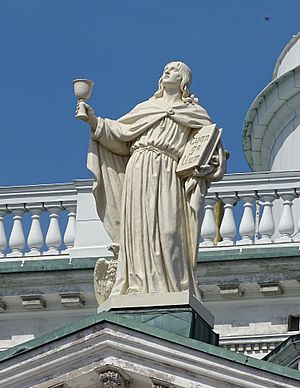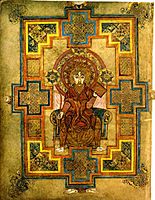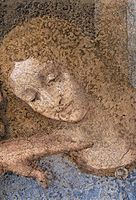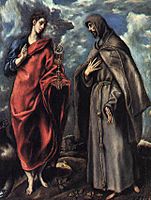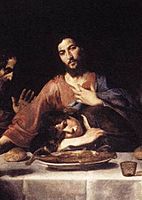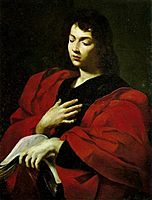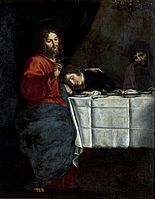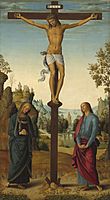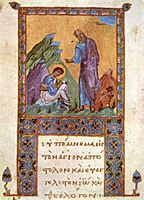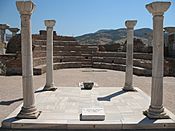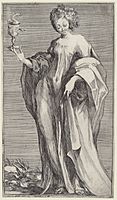John the Apostle facts for kids
Quick facts for kids Saint John the Apostle |
|
|---|---|
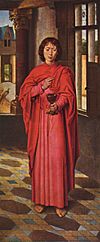 |
|
| Apostle | |
| Born | c. AD 6 Bethsaida, Galilee, Roman Empire |
| Died | c. AD 100 (aged 93–94) place unknown, traditionally assumed to be Ephesus, Roman Empire |
| Venerated in | Christianity |
| Canonized | Pre-congregation |
| Feast | 27 December (Roman Catholic, Anglican) 26 September (Orthodox) |
| Attributes | Book, a serpent in a chalice, cauldron, eagle |
John the Apostle was an important follower of Jesus. He was one of the Twelve Apostles. People believe he was the youngest of the apostles. His brother, James, was also one of the Twelve Apostles.
Many people believe John wrote some books in the New Testament. These include the Gospel of John, three Epistles of John, and the Book of Revelation. He is sometimes called John the Evangelist or the "Beloved Disciple."
Contents
John's Early Life and Calling
John was the son of a man named Zebedee. His mother was Salome. John and his brother James worked as fishermen with their father. They fished in the Sea of Galilee.
Before meeting Jesus, John and James were followers of John the Baptist. Later, Jesus asked them to follow him. He also called Peter and Andrew to join him.
Sons of Thunder
Jesus gave John and James a special nickname: "Boanerges." This means "sons of thunder." Even though they were usually calm, they could become very strong and loud when they were upset.
One story says the brothers wanted to call down fire on a town. But Jesus stopped them. John lived for many years after his brother James died. James was the first apostle to die for his faith.
Later Life and Legacy
It is believed that John was the youngest apostle. He also lived longer than the other apostles. He is thought to have died in a city called Ephesus. This happened sometime after the year AD 98.
Many believe John's tomb is in Selçuk. This is a small town near Ephesus.
Feast Day
Christians celebrate Saint John's life on a special day. In the Roman Catholic Church, this day is December 27. It is called "Saint John, Apostle and Evangelist."
The Anglican Communion and Lutheran churches also celebrate him. They call him "Saint John the Apostle and Evangelist." The traditional color for this celebration is white.
John in Art
John has been shown in art for a very long time. Artists usually show him in two ways. He is either an old man with a white beard. Or he is a young man without a beard.
Older art from the Byzantine Empire often showed him as an old man. This might have been inspired by old pictures of Socrates. In Medieval Western Europe, he was often shown as a young man. This way of showing him started around the 4th century in Rome.
Images for kids
- John the Apostle
-
A portrait from the Book of Kells, around 800 AD.
-
From The Last Supper by Leonardo da Vinci, around the 1400s.
-
John the Apostle and St Francis by El Greco, around 1600-1614.
-
Valentin de Boulogne, John and Jesus.
-
St. John at the Crucifixion of Jesus in a Stabat Mater by Pietro Perugino, around 1482.
-
The Tomb of Saint John the Apostle, at Saint John's Basilica in Selçuk, Turkey.
See also
 In Spanish: Juan el Apóstol para niños
In Spanish: Juan el Apóstol para niños


